|
home | purchase | services | contact | about |
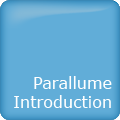
|
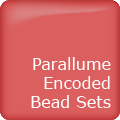
|

|
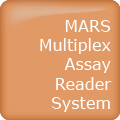
|

|
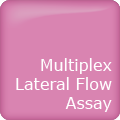
|

|

|
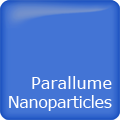
|
|
Introduction |
 |
|
The rare earth-based Parallume optical encoding materials enable for the first time the multiplexing of arbitrarily large numbers of samples including assays based on nucleic acids or protein-antibody pairs or the multiplexed immunohistochemical staining of cells and tissues. MultiplexingA multiplexed assay refers to the simultaneous screening within a single container of a multicomponent Target mixture against a large number of probes each of which gives information about a particular constituent or component of the target mixture. The hybridization of a DNA microarray with 1000 probes against a single target mixture is a multiplexed assay whereas an assay performed separately in 1000 microtiter plate wells is not. The multiplexing of N sample assays has many advantages over serial high throughput protocols including: Fig. 1 A photomicrograph of Parallume-encoded beads under 320 nm excitation. In optical multiplexing, a given probe is attached to a bead with a unique optical signature allowing reactions of that probe to be optically distinguished from other beads possessing other probes when the beads are pooled.
Optical MultiplexingThe identity of each probe used when multiplexing with microarrays is known from its geometric location within the array but this requires loading the probe onto a precisely known location on the substrate. In optical multiplexing, the probes are attached to encoded beads or nanoparticles, which are loaded randomly into the assay container without regard to the order, sequence or timing of addition, and the identity of each probe determined from a unique optical signature emitted from each bead or nanoparticle (Fig. 1). The optical signature may be based on either measurement of (a) the absolute intensities of the various emitter colors or (b) ratios among emitter colors. The most desirable and useful optical multiplexing platform technology would include:
The fact that current multiplexing technology, which is based on mixtures of organic dyes, is limited to a few dozen optical codes is primarily a result of the broad emission peak widths. This spectral overlap, rapid photobleaching and the requirement for a separate laser excitation source for each dye color prevents accurate determination of the relative brightness of two emitters. Recent work on optical encoding with quantum dots has shown that, in addition to the toxicity and difficulty in conjugating biocontent, it not possible to create more than a few optical codes with quantum dots because of large changes in emission intensity with pH, buffer, unstable emission, etc. which are different for each quantum dot color. The Parallume optical encoding technology presented here directly addresses these issues. Optical Multiplexing with Parallume MaterialsThe Parallume encoding materials, which are based on exceedingly stable, solid state inorganic oxides containing multicolor rare earth emitters, are essentially immutable and cannot be photobleached [n2], oxidized or dissolved and emission is independent of any environmental factors. Very importantly, the Parallume materials are excited and emit all colors using a single excitation source. The emission spectrum of a typical Parallume optical encoding material is shown in Fig. 2 and illustrates that emission from the multiple Parallume rare earth emitters (peak width = 2-10 nm FWHM) is far narrower than that from typical organic dyes or quantum dots (e.g., 28nm for QD625, 33nm for Cy5, 46nm for Oregon Green and 65nm for QD705FWHM).  Fig. 2 A comparison of the peak width of the fluorescent emission from organic dyes, quantum dots and a single 5-emitter Parallume composition. The emission peaks of the rare earth Parallume encoding materials display much less spectral overlap than organic dyes. This allows orders of magnitude more optical codes to be resolved with Parallume encoding than is possible when encoding with dyes or quantum dots. The near baseline resolution of the different Parallume rare earth emitters allows very accurate determination of the relative fluorescent intensity of the emitters resulting in a far larger number of available optical codes than any other current optical multiplexing technology. Table 1 summarizes the features, advantages and benefits when using Parallume optical encoding materials compared to dyes or quantum dots. |
||||||||||||||||||
|
Table 1: Advantages of Parallume Encoding Materials
Ratiometric Optical CodesIn some optical encoding technologies, every bead must be exactly the same diameter (volume) because absolute intensity measurements are needed. For example, some optically encoded beads for flow cytometry must be exactly the same size which results in a very high cost. Because the intensity of the multicolor, narrow band Parallume rare earth emission peaks may be measured so accurately, Parallume encoding can create optical codes based onthe intensity ratios of colors instead of their relative absolute intensity as illustrated schematically in Fig. 3. The optical code is now independent of bead or particle size and brightness of the excitation source. 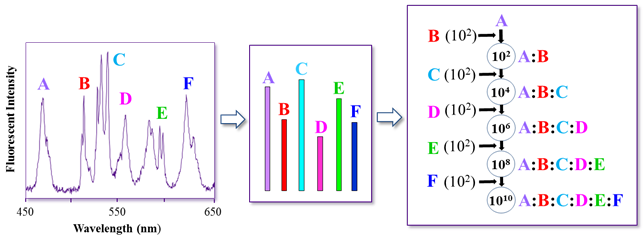 Fig. 3 Parallume encoding uses optical codes based on ratiometric instead of absolute intensity measurements to eliminate difficulties in code rendering from changes in sample size, excitation source brightness or angle of illumination. The hexanary oxide (1) emits six different colors (left) whose relative intensities are schematically illustrated (center). Since we can resolve >100 binary ratios between two colors (see below) the 6-color Parallume system shown can yield ten billion resolvable optical codes. Ten Billion Parallume Optical CodesUsing a ternary Parallume system as an example, Fig. 4 shows there are at least 100 resolvable ratios for binary color pairs. As shown in Fig. 3, there are around 10 billion resolvable Parallume optical codes for six colors and a 1% compositional resolution limit. 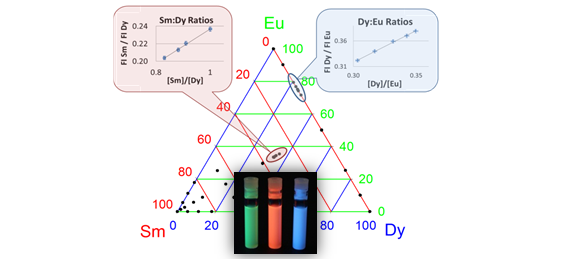 Fig. 4 The ratio of emitted light (inset) to the molar ratio of two emitters is linear and is shown for selected compositions from the ternary Dy-Er-Sm phase diagram. The Dy, Er and Sm emitter amounts are given as a percentage of their total a, b and c in the Parallume material of formula Y1-x[DyaErbSmc]xVO4 where a = c = 0.001 and b = 0.002. The data indicates that there are at least 100 resolvable ratiometric optical codes for each emitter pair or MN-1 optical codes for M resolvable binary ratios and n different emitter colors. Inset: Tm, Sm and Er Parallume nanoparticles suspensions (302nm excitation). |
Copyright © 2000-2015 Parallel Synthesis Technologies, Inc. |